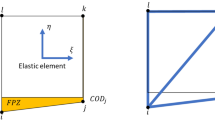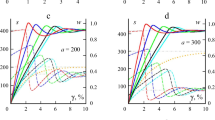Abstract
The optical method of caustics for measuring the dynamic stress intensity factor in a transient process is investigated in this study. The transient full-field solutions of a propagating crack contained in an infinite medium subjected to step-stress wave and ramp-stress wave loadings are used to establish the exact equations of the initial and caustic curves. The results of the stress intensity factor obtained from the caustic method are compared with theoretical predictions and some experiments. The results demonstrate that a significant deviation can occur in the determination of the dynamic stress intensity factor from shadow spot measurements. The factors, such as screen distance, magnitude of loading, crack speed and rising time which can influence the accuracy of the experimental measurements are discussed in detail. In addition, the valid region of the dynamic stress singular field for the propagating crack is discussed in detail and it gives a better understanding of the appropriate region of measurements for investigators.
Similar content being viewed by others
References
Aoki, S. and Kimura, T. (1993). finite element study on the optical method of caustic for measuring impact fracture toughness. Journal of the Mechanics and Physics of Solids 41, 413–425.
Freund, L.B. (1990). Dynamic Fracture Mechanics, Cambridge University Press, Cambridge.
Freund, L.B. and Rosakis, A.J. (1990). The Influence of Transient Effects on the Asymptotic Crack Tip Field during Dynamic Crack Growth, Eleven National Congress of Applied Mechanics, Tucson, Arizona.
Freund, L.B. and Rosakis, A.J. (1992). The structure of the near tip field during transient elastodynamic crack growth. Journal of the Mechanics and Physics of Solids 40, 699–719.
Krishnaswamy, S. and Rosakis, A.J. (1991). On the extent of dominance of asymptotic elastodynamic crack-tip fields: Part 1 — An experimental study using bifocal caustics. Journal of Applied Mechanics 58, 87–94.
Liu, C., Rosakis, A.J. and Freund, L.B. (1993). The interpretation of optical caustics in the presence of dynamic nonuniform crack-tip motion histories: A study based on a higher order transient crack-tip expansion. International Journal of Solids and Structures 30, 875–897.
Ma, C.C. (1990). The influence of singular field dominance on the caustic methods. Optics and Lasers in Engineering 13, 279–304.
Ma, C.C. and Freund, L.B. (1986). The extent of the stress intensity factor field during crack growth under dynamic loading conditions. Journal of Applied Mechanics 53, 303–310.
Manogg, P. (1964). Anwendungen der Schattenoptik zur Untersuchung des Zerreissvorgags von Platten, Dissertationsschrift an der Universität Freiburg, Germany.
Ravi-Chandar, K. and Knauss, W.G. (1984a). An experimental investigation into dynamic fracture: I. Crack initiation and arrest. International Journal of Fracture 25, 247–262.
Ravi-Chandar K. and Knauss, W.G. (1984b). An experimental investigation into dynamic fracture: II. Microstructural aspects. International Journal of Fracture 26, 65–80.
Ravi-Chandar, K. and Knauss, W.G. (1984c). An experimental investigation into dynamic fracture: III. On steady-state crack propagation and crack branching. International Journal of Fracture 26, 141–154.
Ravi-Chandar, K. and Knauss, W.G. (1984d). An experimental investigation into dynamic fracture: IV. On the interaction of stress waves with propagating cracks. International Journal of Fracture 26, 189–200.
Ravi-Chandar, K. and Knauss, W.G. (1987). On the characterization of the transient stress field near the tip of a crack. Journal of Applied Mechanics 54, 72–78.
Rosakis, A.J. (1980). Analysis of the optical method of caustics for dynamic crack propagation. Engineering Fracture Mechanics 13, 331–347.
Rosakis, A.J. and Freund, B. (1981). The effect of crack tip plasticity on the determination of dynamic stress intensity factors by the optical method of caustics. Journal of Applied Mechanics 48, 302–308.
Rosakis, A.J., Ma, C.C. and Freund, L.B. (1983). Analysis of the optical shadow spot method for a tensile crack in a power-law hardening material. Journal of Applied Mechanics 50, 777–782.
Rosakis, A.J. and Zehnder, A.T. (1985). On the method of caustics: An exact analysis based on geometrical optics. Journal of Elasticity 15, 347–367.
Rosakis, A.J. and Ravi-Chandar, K. (1986). On crack-tip-stress state: An experimental evaluation of three dimensional effects. International Journal of Solids and Structures 22, 121–134.
Schardin, H. (1959). Velocity effects in fracture. Fracture (Edited by B.L. Averback et al.), John Wiley and Sons, New York.
Theocaris, P.S. (1971). Reflected shadow method for the study of constrained zones in cracked plates. Applied Optics 10(1971), 2240–2247.
Theocaris, P.S. and Gdoutos, E.E. (1974). The modified Dugdale-Barenblatt model adapted to various fracture configurations in metals. International Journal of Fracture 10, 549–564.
Tsai, C.H. and Ma, C.C. (1992). Transient analysis of a semi-infinite crack subjected to dynamic concentrated forces. Journal of Applied Mechanics 59, 804–811.
Author information
Authors and Affiliations
Rights and permissions
About this article
Cite this article
Ing, YS., Ma, CC. Theoretical simulations of a propagating crack subjected to in-plane stress wave loading by caustic method. International Journal of Fracture 85, 313–331 (1997). https://doi.org/10.1023/A:1007446315960
Issue Date:
DOI: https://doi.org/10.1023/A:1007446315960




